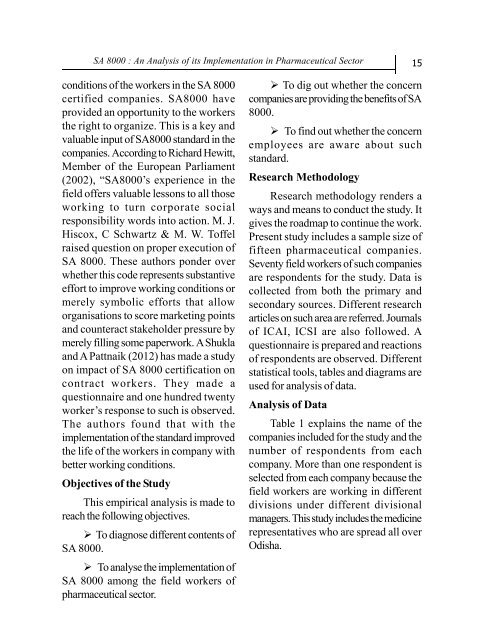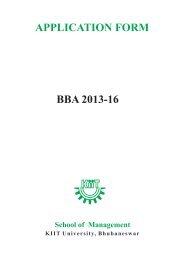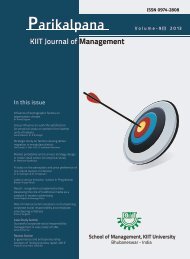Download - School of Management, KIIT University
Download - School of Management, KIIT University
Download - School of Management, KIIT University
Create successful ePaper yourself
Turn your PDF publications into a flip-book with our unique Google optimized e-Paper software.
SA 8000 : An Analysis <strong>of</strong> its Implementation in Pharmaceutical Sector<br />
15<br />
conditions <strong>of</strong> the workers in the SA 8000<br />
certified companies. SA8000 have<br />
provided an opportunity to the workers<br />
the right to organize. This is a key and<br />
valuable input <strong>of</strong> SA8000 standard in the<br />
companies. According to Richard Hewitt,<br />
Member <strong>of</strong> the European Parliament<br />
(2002), “SA8000’s experience in the<br />
field <strong>of</strong>fers valuable lessons to all those<br />
working to turn corporate social<br />
responsibility words into action. M. J.<br />
Hiscox, C Schwartz & M. W. T<strong>of</strong>fel<br />
raised question on proper execution <strong>of</strong><br />
SA 8000. These authors ponder over<br />
whether this code represents substantive<br />
effort to improve working conditions or<br />
merely symbolic efforts that allow<br />
organisations to score marketing points<br />
and counteract stakeholder pressure by<br />
merely filling some paperwork. A Shukla<br />
and A Pattnaik (2012) has made a study<br />
on impact <strong>of</strong> SA 8000 certification on<br />
contract workers. They made a<br />
questionnaire and one hundred twenty<br />
worker’s response to such is observed.<br />
The authors found that with the<br />
implementation <strong>of</strong> the standard improved<br />
the life <strong>of</strong> the workers in company with<br />
better working conditions.<br />
Objectives <strong>of</strong> the Study<br />
This empirical analysis is made to<br />
reach the following objectives.<br />
‣ To diagnose different contents <strong>of</strong><br />
SA 8000.<br />
‣ To analyse the implementation <strong>of</strong><br />
SA 8000 among the field workers <strong>of</strong><br />
pharmaceutical sector.<br />
‣ To dig out whether the concern<br />
companies are providing the benefits <strong>of</strong> SA<br />
8000.<br />
‣ To find out whether the concern<br />
employees are aware about such<br />
standard.<br />
Research Methodology<br />
Research methodology renders a<br />
ways and means to conduct the study. It<br />
gives the roadmap to continue the work.<br />
Present study includes a sample size <strong>of</strong><br />
fifteen pharmaceutical companies.<br />
Seventy field workers <strong>of</strong> such companies<br />
are respondents for the study. Data is<br />
collected from both the primary and<br />
secondary sources. Different research<br />
articles on such area are referred. Journals<br />
<strong>of</strong> ICAI, ICSI are also followed. A<br />
questionnaire is prepared and reactions<br />
<strong>of</strong> respondents are observed. Different<br />
statistical tools, tables and diagrams are<br />
used for analysis <strong>of</strong> data.<br />
Analysis <strong>of</strong> Data<br />
Table 1 explains the name <strong>of</strong> the<br />
companies included for the study and the<br />
number <strong>of</strong> respondents from each<br />
company. More than one respondent is<br />
selected from each company because the<br />
field workers are working in different<br />
divisions under different divisional<br />
managers. This study includes the medicine<br />
representatives who are spread all over<br />
Odisha.







